Understanding Candida auris

What is Candida auris?
Candida auris (C. auris) is a type of yeast and is an emerging fungal pathogen that can cause infections anywhere in the body, including severe invasive infections such as bloodstream infections. It was first identified in Japan in 2009, and infections have now been reported on every populated continent, including in North America and the United States. The risk to the general public and otherwise healthy people, including healthcare workers, is extremely low.1,2 In hospitalized patients, it can cause severe illness. C. auris can colonize the skin and has been isolated from multiple infection sites in the body. There are limited antifungal drugs available to treat Candida infections and like other “superbugs,” C. auris is often resistant to one or more of these antimicrobial agents. Additionally challenging, C. auris is difficult to identify with standard laboratory testing.3 Healthcare transmission is responsible for most, if not all, cases.1,2
C. auris Symptoms
Candida auris infection symptoms can vary greatly and are specific to the infected body site. The most common symptoms of invasive Candida infection are fever and chills that do not improve after antibiotic treatment for a suspected bacterial infection.4
Incubation Period and Duration of Illness
The incubation period of C. auris from exposure to infection is currently unknown because this pathogen can colonize the skin for months or years without entering the body and causing an infection and symptoms. Duration of illness is multifactorial — depending on the body site infected and the patient's baseline health.
Who Is At Risk?
Candida auris primarily affects patients in healthcare settings who are vulnerable due to preexisting health conditions or the need for invasive medical devices. Risk factors include being on mechanical ventilation machines, having a tracheostomy, presence of invasive devices such as central lines, prolonged or multiple stays in a healthcare facility, particularly long-term care, and recent use of antimicrobials.6 Patients at highest risk of an invasive Candida infection are usually already ill from other medical conditions or have spent a prolonged time in healthcare settings — particularly long-term acute care hospitals (LTACHS) or ventilator-capable skilled nursing facilities (vSNFs) — and have lines and tubes that go into their body (such as breathing tubes, feeding tubes and central venous catheters), making them more vulnerable.
The Burden of C. auris
Since 2016 when the first U.S. case of C. auris was diagnosed and confirmed, there has been a steady increase in the number of cases. The disease burden has grown annually from 51 confirmed cases in 2016 to 4,514 new confirmed cases in 2023.2 A 95% increase in clinical cases was observed between 2020 and 2021.1 As this pathogen is monitored, it is important to also continue surveillance of drug-resistant C. auris strains. Between 2019 and 2021, the number of U.S. drug-resistant C. auris cases increased by threefold from the previous year.1
How C. auris Spreads
Direct and Indirect Contact
As the pathogen that colonizes the skin, C. auris can spread person-to-person via direct contact from either a colonized or infected individual.4 One of the biggest issues with C. auris is that infected patients shed the pathogen from their skin into the immediate environment where surfaces become contaminated. Shared or portable medical equipment has been identified as an important source for disease transmission.
Preventing the Spread of C. auris
Hand Hygiene
It is important to practice proper and frequent hand hygiene techniques when interacting with C. auris patients. Use hand sanitizer unless hands are visibly soiled. Follow facility hand hygiene policy.
Cleaning and Disinfecting Surfaces
The CDC recommends use of a hospital-grade disinfectant that is registered with the Environmental Protection Agency (EPA) and is effective against C. auris (see EPA List P).10 If a product with an EPA claim is not accessible or otherwise suitable, the CDC recommends using a sporicidal disinfectant (see EPA List K).11 Disinfectants with an EPA claim for C. difficile have been used effectively against C. auris. It is important to follow the directions for use, including applying the product for the stated contact time. Increased attention to detail and monitoring for compliance should include:
- Surfaces in patient rooms, with special attention to high-touch surfaces and the bed-space area
- Surfaces in areas where patients receive care (e.g., radiology, physical therapy, etc.)
- Mobile and shared equipment (e.g., ventilators, vital signs machines, physical therapy equipment, thermometer probes)5
Isolation Precautions
Identify and isolate patients that test positive for C. auris. Wear gloves and gowns in C. auris isolation rooms when delivering care.6 Clean and disinfect the patient’s room with appropriate disinfectants often. Wash hands often and especially before leaving the patient’s room.6
CloroxPro Products Effective Against C. auris
A number of Clorox Healthcare cleaner disinfectants can be used to effectively manage Candida auris on environmental surfaces and equipment in healthcare settings. The contact time, or wet time, is the time that the surface must remain visibly wet for the disinfectant to be effective against the specific pathogen. Always follow the label’s directions for use when cleaning and disinfecting.
| PRODUCT | PRODUCT IMAGE | EPA REG. NO. | C. AURIS CONTACT TIME (EPA LIST P) | C. DIFF CONTACT TIME (EPA LIST K) |
|---|---|---|---|---|
| Clorox Healthcare Bleach Germicidal Wipes 6″ x 5″ Clinical Wipes, 6/150 ct., Item No. 30577 6.75″ x 9″ Multipurpose Wipes, 6/70 ct., Item No. 35309 6.75″ x 9″ Softpack, 9/100 ct., Item No. 32621 6.75″ x 9″ Individual Wipes, 6/50 ct., Item No. 31424 12″ x 12″ Terminal Wipes, 2/110 ct., Item No. 30358 12″ x 12″ Terminal Wipes Refill, 2/110 ct., Item No. 30359 | 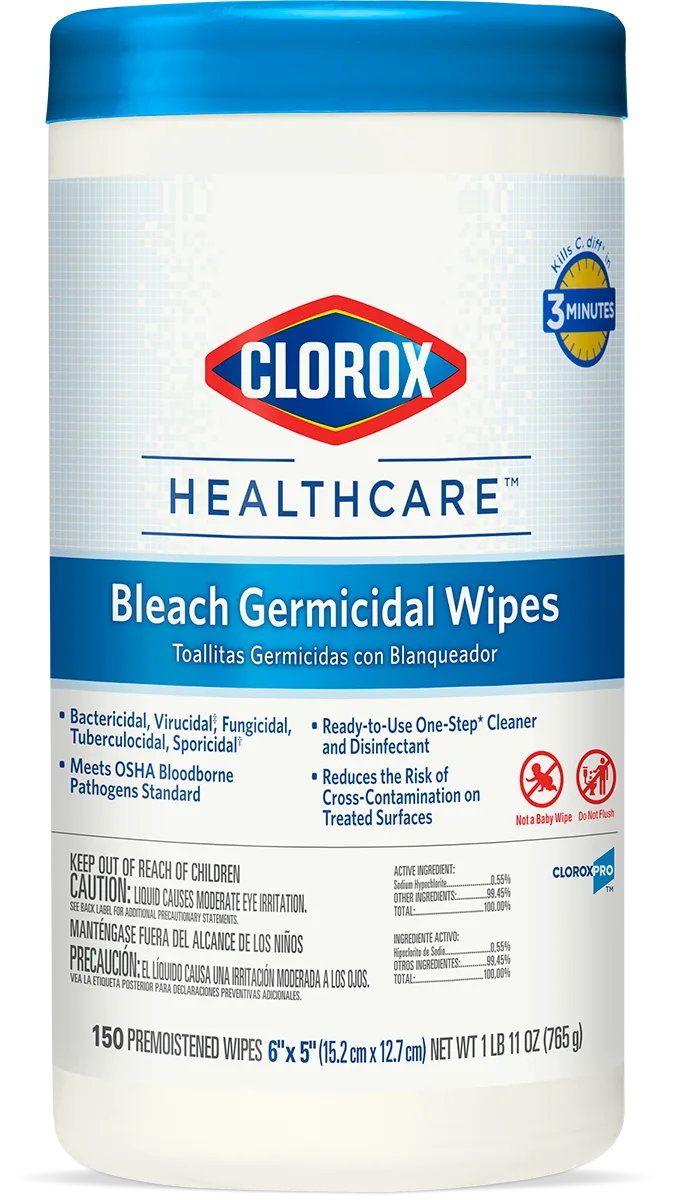 | 67619-12 | 3 min | 3 min |
| Clorox Healthcare Bleach Germicidal Cleaner 6/32 fl. oz. Spray, Item No. 30577 6/32 fl. oz. Pull-Top, Item No. 68832 4/128 fl. oz. Refill, Item No. 68978 | 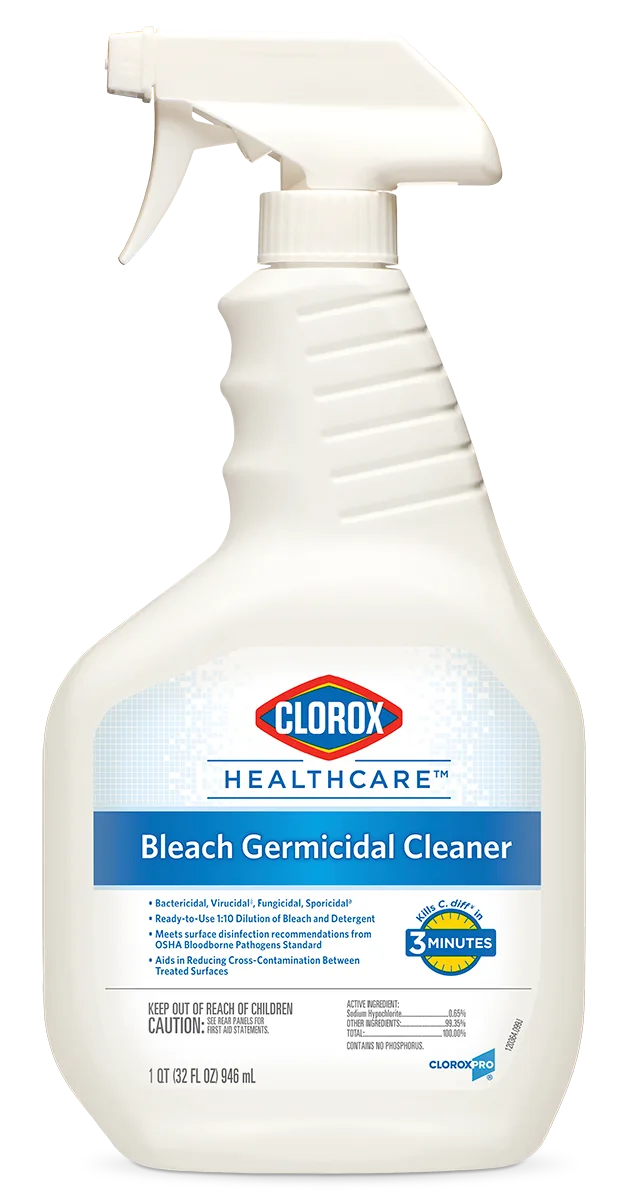 | 56329-7 | 3 min | 3 min |
| Clorox Healthcare Spore10 Defense Cleaner Disinfectant 4/128 fl. oz. for Total 360 Devices, Item No. 32122 4/128 fl. oz. Ready-to-use, Item No. 32409 | 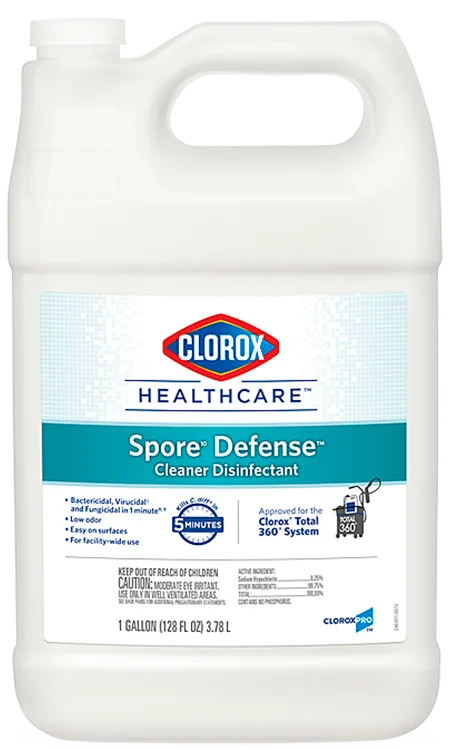 | 67619-40 | 3 min | 5 min |
| Clorox Healthcare Hydrogen Peroxide Cleaner Disinfectant Liquids 9/32 fl. oz. Spray, Item No. 30828 6/32 fl. oz. Pull-Top, Item No. 31444 4/128 fl. oz. Refill, Item No. 30829 | 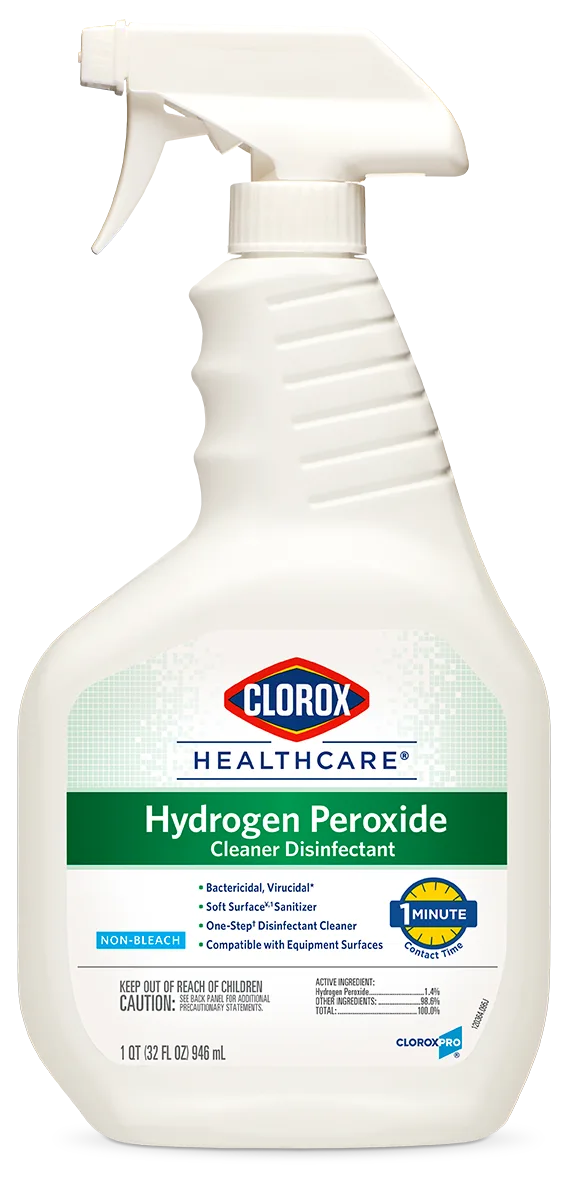 | 67619-24 | 2 min | — |
| Clorox Healthcare Hydrogen Peroxide Cleaner Disinfectant Wipes 6.75″ x 9″ Multipurpose Wipes, 6/95 ct., Item No. 30824 6.75″ x 5.75″ Clinical Wipes, 6/155 ct., Item No. 30825 12″ x 11″ Terminal Wipes, 2/185 ct. bucket, Item No. 30826 12″ x 11″ Terminal Wipes, 2/185 ct. refill pouch, Item No. 30827 | 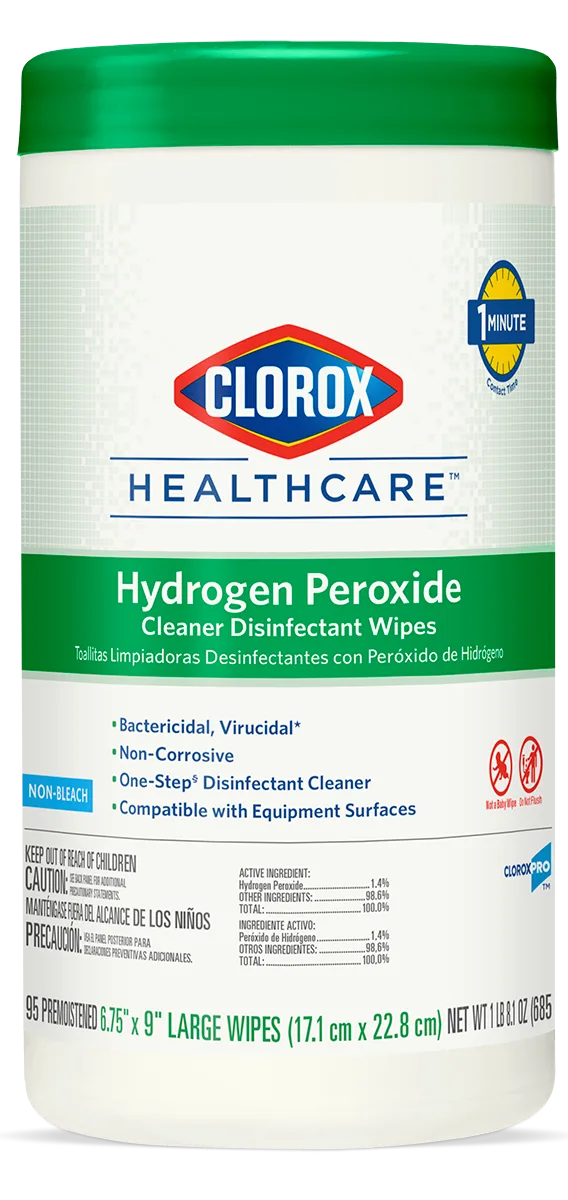 | 67619-25 | 2 min | — |
| Clorox Healthcare Fuzion Cleaner Disinfectant 9/32 fl. oz. Spray, Item No. 31478 |  | 67619-30 | — | 90 sec |
| Dispatch Hospital Cleaner Disinfectant Towels 6.75″ x 8″ Canister, 8/150 ct., Item No. 69150 | 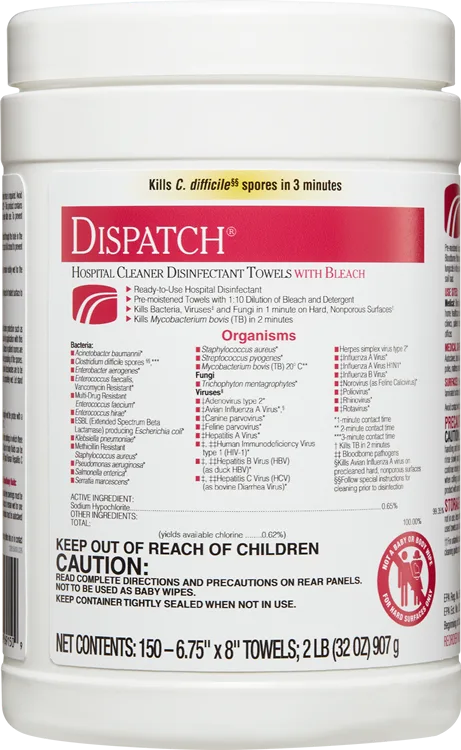 | 56392-8 | — | 3 min |
| Clorox Germicidal Bleach 3/121 fl. oz. Bottle, Item No. 30966 |  | 67619-32 | — | 3 min |
Other Resources
Educational Resources
- Candida auris Pathogen Education Sheet
- C. auris Cleaning and Disinfection Toolkit
- What Is Candida auris (C. auris)?
- Candida auris: When to Screen and When to Identify Species
Educational Courses (CE Credits Available)
Clinical Evidence
Blog Posts
References
1. Lyman M, Forsberg K, Sexton DJ, Chow N, Lockhart SR, Jackson BR, Chiller T. Worsening Spread of Candida auris in the United States, 2019-2021. Ann Intern Med. 2023 Mar; https://doi.org/10.7326/M22-3469.
2. CDC. (2024, May 16). Tracking C. auris. Candida Auris (C. Auris). https://www.cdc.gov/candida-auris/tracking-c-auris/?CDC_AAref_Val=https://www.cdc.gov/fungal/candida-auris/tracking-c-auris.html (Accessed August 1, 2025).
3. World Health Organization (WHO). WHO fungal priority pathogen list to guide research, development and public health action [Internet]. from https://www.who.int/publications/i/item/9789240060241.
4. CDC. (2024, May 14). Candida auris. Candida Auris (C. Auris). https://www.cdc.gov/candida-auris/index.html (Accessed August 1, 2025).
5. Centers for Disease Control and Prevention. (2024, June 13). Infection Control Guidance: Candida auris. Candida Auris (C. Auris). https://www.cdc.gov/candida-auris/hcp/infection-control/index.html (Accessed August 1, 2025).
6. CDC. (2024, May 10). Preventing the Spread of C. auris. Candida Auris (C. Auris). https://www.cdc.gov/candida-auris/prevention/index.html (Accessed August 1, 2025).
7. CDC. (2024, May 15). Identification of C. auris. Candida Auris (C. Auris). https://www.cdc.gov/candida-auris/hcp/laboratories/identification-of-c-auris.html (Accessed August 1, 2025).
8. CDC. (2024, June 24). Screening for C. auris. Candida Auris (C. Auris). https://www.cdc.gov/candida-auris/screening/index.html (Accessed August 1, 2025).
9. CDC. (2024, April 30). Clinical Care of C. auris infections. Candida Auris (C. Auris). https://www.cdc.gov/candida-auris/hcp/clinical-care/index.html (Accessed August 1, 2025).
10. List P: Antimicrobial Products Registered with EPA for Claims Against Candida auris | US EPA https://www.epa.gov/pesticide-registration/list-p-antimicrobial-products-registered-epa-claims-against-candida-auris (Accessed August 1, 2025).
11. List K: EPA’s Registered Antimicrobial Products Effective against Clostridium difficile Spores | US EPA https://www.epa.gov/pesticide-registration/list-k-epas-registered-antimicrobial-products-effective-against-clostridium (Accessed August 1, 2025).
12. Wißmann, J. E., Kirchhoff, L., Brüggemann, Y., Todt, D., Steinmann, J., & Steinmann, E. (2021). Persistence of Pathogens on Inanimate Surfaces: A Narrative Review. Microorganisms, 9(2), 343. https://doi.org/10.3390/microorganisms9020343













